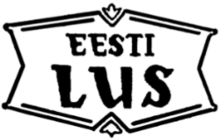Estonian Naturalists' Society
Estonian Naturalists' Society (Estonian: Eesti Looduseuurijate Selts, ELUS) is the oldest Estonia-based society of naturalists. It was founded in 1853, and since establishing has been the major scientific organisation focusing on natural history of Estonia.

Logo
The Society is based in Tartu. It has been associated with Tartu University and the Estonian Academy of Sciences. The society still operates (2018) and claims to be the oldest scientific society in the Baltic states.[1]
The Society owns a rich library that is specialised on the publications about Estonian nature.
Presidents of the Society
- Carl Eduard von Liphardt (1853–1862)[1]
- Guido Samson von Himmelstiern (1862–1868)
- Carl Johann von Seidlitz (1868–1869)
- Karl Ernst von Baer (1869–1876)
- Friedrich von Bidder (1877–1890)
- Johann Georg Dragendorff (1890–1893)
- Carl Schmidt (1894)
- Edmund August Friedrich Russow (1895–1897)
- Julius von Kennel (1898–1899)
- Karl Gottfried Constantin Dehio (1899–1901)
- Grigori Levitski (1901–1905)
- Nikolai Kuznetsov (1905–1911)
- Jevgeni Shepilevski (1911–1918)
- Boriss Sreznevski (1918)
- Georg Landesen (1918–1923)
- Johannes Piiper (1923–1929)
- Paul Kogerman (1929–1936)
- Hugo Kaho (1936–1939)
- Teodor Lippmaa (1939–1942)
- Armin Öpik (1944)
- Karl Orviku (1946–1952)
- Harald Haberman (1952–1954)
- Eerik Kumari (1954–1964)
- Hans-Voldemar Trass (1964–1973 and 1985–1991)
- Erast Parmasto (1973–1976)
- Kuulo Kalamees (1976–1985)
- Kalevi Kull (1991–1994)
- Tõnu Möls (1994–2004)
- Marek Sammul (2004–2008)
- Tõnu Viik (2008–2014)
- Oive Tinn (2014–)
gollark: The market system, by giving *each individual participant* a direct incentive to improve things, is more efficient.
gollark: Not the same thing, really.
gollark: Outsourcing *increases* efficiency, which is why it's done.
gollark: In CommunismLand™, if you have a good idea, you must present your good idea to the CommunismCommitee™, who will review it, and then possibly throw it out since it threatens their position, or implement it after about 5 years and when they finish updating plans to include it.
gollark: That's more of a regulatory capture and insufficient personal freedom problem.
References
- History Archived 2014-01-01 at the Wayback Machine, Estonian Naturalists Society, retrieved 31 December 2013
This article is issued from Wikipedia. The text is licensed under Creative Commons - Attribution - Sharealike. Additional terms may apply for the media files.